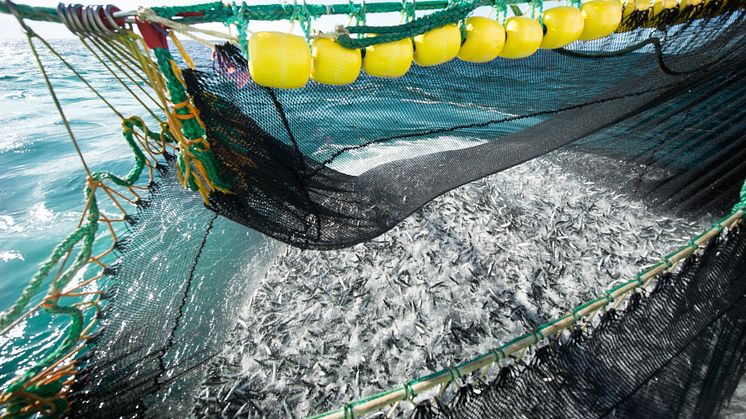
Press release -
Large fall in seafood exports in November
In November, the value of Norwegian seafood exports was NOK 9.4 billion. This is a decrease in value of 11 per cent, or NOK 1.2 billion, compared to November 2019.
So far this year, seafood exports total NOK 96.6 billion. This is a decrease of NOK 1 billion, or 1 per cent, when compared against the same period last year.
“Norwegian seafood exports are now seeing the impact of a hotel and restaurant sector that has more or less shut down across Europe. In addition, the demand for traditional products such as clipfish and stockfish which are often eaten at larger dinners with friends and family has fallen due to the restrictions on mixing households”, says director of market insight and market access in the Norwegian Seafood Council, Tom-Jørgen Gangsø.
Significant drop in demand
“November 2019 was an exceptionally strong month, so that should also be taken into account when comparing year-on-year performance. At the same time, the fall in export value would have been greater if the Norwegian kroner had not been so weak”, says Gangsø.
“The large Christmas sales of seafood this year must be covered by the retail trade, but it will not be enough to offset the loss of demand from the restaurants. A result of this is a significantly reduced price for most of the seafood products”, says Tom-Jørgen Gangsø.
Poland, Denmark and France were the largest export markets for Norwegian seafood in November.
Mackerel exports have been the month´s highlight
“We experienced a decline across almost the entire line in November. The big bright spot is mackerel, and we are also seeing growth in king crab exports. Together with herring, mackerel is a product that is mainly sold in the grocery trade, has a long shelf life and is cheaper than many other products. During the corona crisis, there has been increased demand for herring and mackerel, and we see that the export value for these species has already exceeded last year”, says Tom-Jørgen Gangsø.
Decline in value for salmon
- 108,000 tonnes of salmon worth NOK 5.8 billion were exported in November.
- The volume increased by 1 per cent.
- The value fell by NOK 991 million, or 15 per cent, compared with November last year.
- Poland, France and Denmark were the largest markets for Norwegian salmon in November.
In November, the export price for salmon was NOK 47.97 per kilo, which was 19 per cent lower than in the same month 2019.
“Due to the corona situation and a reduced turnover in the restaurant sector, salmon is not able to reach the record price highs we saw before Christmas last year. The fall in value could actually have been greater, but this is offset by increased sales of salmon fillets”, says Paul T. Aandahl, Seafood Analyst with the Norwegian Seafood Council.
- So far this year, 1 million tonnes of salmon worth NOK 64 billion have been exported.
- Volume remains at the same level as last year, while the value fell by NOK 1.6 billion, or 2 per cent.
Trout exports remain stable
- 6,200 tonnes of trout worth NOK 352 million were exported in November
- Export volume fell by 8 per cent.
- Export value fell by NOK 28 million, or 7 per cent, compared with November last year.
- Belarus, Japan and the USA were the largest markets for Norwegian trout in November.
“Compared with salmon, trout has seen less severe falls in value in November. Traditionally, relatively little Norwegian trout is sold for consumption outside the home, and it is therefore less affected by the restaurant sector closures” says seafood analyst Paul T. Aandahl from the Norwegian Seafood Council.
The average price for fresh whole trout in November was NOK 52.49 per kg, which is 1.5 per cent lower than in the same month last year. It is the first time since March 2019 that the price for fresh trout is higher than for fresh whole salmon.
- So far this year, 66,000 tonnes of trout have been exported for NOK 3.6 billion.
- There is an increase in volume of 22 per cent, while the value increased by NOK 243 million, or 7 per cent.
Decline for fresh cod
- Norway exported 2,000 tonnes of fresh cod, including fillets, worth NOK 94 million in November.
- Export volume fell by 32 per cent.
- Export value fell by NOK 47 million, or 33 per cent, compared with November last year.
- Denmark, Sweden and Germany were the largest markets for fresh cod from Norway in November.
“Some bad weather in November has led to fewer landings of fresh cod, and this is also reflected in exports”, says Ingrid Kristine Pettersen, Seafood Analyst with the Norwegian Seafood Council.
- So far this year, 46,000 tonnes of fresh cod have been exported for NOK 2.1 billion.
- This is a reduction in volume of 7 per cent, while export value fell by NOK 115 million, or 5 per cent.
Lower demand for frozen cod
- Norway exported 6,800 tonnes of frozen cod worth NOK 276 million in November.
- Export volume fell by 7 per cent
- Export value fell by NOK 35 million, or 11 per cent, compared with November last year.
- China, the United Kingdom and Lithuania were the largest markets for frozen cod from Norway in November.
“The decline in volume and falling prices for frozen whole cod is the reason for the decline in value. For frozen fillets, there is still growth, both in volume and price. This can be seen in connection with the fact that several markets are now experiencing a new closure”, says Ingrid Kristine Pettersen, Seafood Analyst with the Norwegian Seafood Council.
Growth in the UK
The United Kingdom is a market that saw growth for both frozen whole cod and frozen fillet of cod in November.
“This is probably due to both a need to secure fish before the turn of the year and the transition to Brexit, but also an increased need for frozen fillets from the grocery trade now that the country has closed down again», says Hans Frode Kielland Asmyhr, the Norwegian Seafood Council's seafood envoy to the UK.
- So far this year, 65,100 tonnes of frozen cod have been exported for NOK 2.9 billion.
- The volume is unchanged, while the value increased by NOK 148 million, or 5 per cent.
A challenging market for clipfish
- Norway exported 7,600 tonnes of clipfish worth NOK 425 million in November.
- Export volume fell by 15 per cent.
- Export value fell by NOK 110 million, or 21 per cent, compared with November last year.
- Portugal, Brazil and the Dominican Republic were the largest markets for Norwegian clipfish in November.
“We have seen a decline for clipfish of both cod and saithe in November. Although there is still growth in the Dominican Republic and Jamaica, it is not enough to offset a continued weak trend in exports to Brazil”, says Ingrid Kristine Pettersen, Seafood Analyst with the Norwegian Seafood Council.
Historical growth
“Sales of clipfish have been historically good in the Dominican Republic throughout the corona period. Volume and value are at an all-time high, with an increase of 20 per cent and 38 per cent respectively for Norwegian saithe clipfish. This is partly because quarantine requirements and curfews have led to people staying at home, where 70 per cent of clipfish is consumed. At the same time, good support schemes have maintained and to some extent increased purchasing power”, says Øystein Valanes, seafood envoy to Brazil for the Norwegian Seafood Council.
- So far this year, 74,700 tonnes of clipfish have been exported for NOK 3.9 billion.
- There is a reduction in volume of 13 per cent, while the value fell by NOK 528 million, or 12 per cent.
Lower prices for salted fish
- Norway exported 2,200 tonnes of salted fish worth NOK 106 million in November.
- There is an increase in volume of 34 percent.
- Export value increased by NOK 25 million, or 30 per cent, compared with November last year.
- Portugal, Italy and Canada were the largest markets for Norwegian salted fish in November.
“The volume growth for salted fish continues in November. Since July, export volumes of whole salted fish of cod have been significantly higher than in the same period in 2019, but at significantly lower prices than at the beginning of the year. From April to November, the price of salted whole cod fell by 23 per cent, measured in Norwegian kroner. This is happening as a result of a fall in demand in important markets”, says Ingrid Kristine Pettersen, Seafood Analyst with the Norwegian Seafood Council.
- So far this year, 24,500 tonnes of salted fish have been exported for NOK 1.4 billion.
- There is an increase in volume of 7 per cent, while the value increased by NOK 143 million, or 11 per cent.
Difficult times for dried fish
- Norway exported 404 tonnes of stockfish worth NOK 74 million in November.
- There is a decrease in export volume of 36 percent.
- Export value fell by NOK 57 million, or 44 per cent, compared with November last year.
- Italy, Croatia and the USA were the largest markets for Norwegian stockfish in November.
“The main reason for the fall in November is due to significantly lower export volumes of whole stockfish of cod to Italy”, says Ingrid Kristine Pettersen, Seafood Analyst with the Norwegian Seafood Council.
The Italian market is complicated
“The decline to Italy is mainly due to new closures, although they are not as extensive as this winter. This means that a large part of the restaurant market and several of the traditional outlets for stockfish, such as fish markets, fishmongers and fishing cars, are closed. Stockfish is simply less available to the Italian consumer. At the same time, it is gratifying to see increasing growth for ready-to-eat stockfish products in supermarkets”, says Trym Eidem Gundersen the Norwegian Seafood Council's seafood envoy to Italy.
- So far this year, 3,600 tonnes of stockfish have been exported for NOK 644 million.
- There is a reduction in volume of 14 per cent, while the value fell by NOK 132 million, or 17 per cent.
Decline for herring
- Norway exported 49,000 tonnes of herring worth NOK 560 million in November.
- There is a decrease in volume of 32 per cent.
- The value fell by NOK 23 million, or 4 per cent, compared with November last year.
- Poland, Lithuania and Germany were the largest markets for Norwegian herring in November.
“The decline in herring exports in November must be seen in light of the fact that November last year was a very strong month. When we look more closely at the figures, we see that herring exports so far this year have already exceeded last year in value. This comes as a result of a shift away from the export of whole frozen herring to more valuable fillet products and processed products”, says Jan Eirik Johnsen, responsible for pelagic strategy with the Norwegian Seafood Council.
In November, the export value of herring fillets increased by 26 per cent, while the value of processed products increased by 13 per cent.
“This is due to increased consumption, and thus increased demand in key markets such as Germany and Poland, which in turn is driven by the corona crisis where good, healthy and cheaper long-term sustainable products are in demand”, says Johnsen.
MSC effect
On 30 November, the certification scheme MSC announced that the certificate for Norwegian spring-spawning herring (NVG herring) will be suspended from 30 December.
«This contributes to an increase in exports to markets such as Germany, who want to secure MSC-certified herring. In addition, the export value of herring roe so far this year has reached NOK 410 million, which is an increase of as much as 153 percent compared to 2019”, says Jan Eirik Johnsen, responsible for pelagic strategy with the Norwegian Seafood Council.
Strong mackerel exports
- Norway exported 58,000 tonnes of mackerel worth NOK 928 million in November.
- This is an increase in export volume of 45 percent.
- Export value increased by NOK 185 million, or 25 per cent, compared with November last year.
- Japan, South Korea and China were the largest markets for Norwegian mackerel in November.
“We now see that the quota increase of 40 per cent compared to 2019 is reflected in higher export volumes. Good demand in the consumer markets Japan, South Korea and Taiwan drive export value upwards. This has resulted in the export value for mackerel already passing last year, which was a peak year for mackerel exports”, says Jan Eirik Johnsen, responsible for pelagic strategy with the Norwegian Seafood Council.
Growth for king crab
- Norway exported 194 tonnes of king crab worth NOK 65 million in November.
- There is an increase in volume of 114 percent.
- Export value increased by NOK 35 million, or 118 per cent, compared with November last year.
- The USA, France and South Korea were the largest markets for Norwegian king crab in November.
“The positive development in export value continues for both frozen and live king crab. The increase is driven by a growth in demand for frozen king crab in Europe and the USA and for live king crab in Asia”, says manager for shellfish in the Norwegian Seafood Council, Josefine Voraa.
Positive development in USA
Norwegian exports of frozen king crab and snow crab to the United States are doing particularly well.
In November, the USA was the largest growth market for king crab, with 50 tonnes worth NOK 21 million. This is an increase of 24 tonnes and NOK 13 million compared with November last year.
Exports of snow crab have also had solid growth, with an increase of 23 tonnes and NOK 7.4 million.
«The most important reason is that we see a craving in the market after the quotas for king crab in Alaska became very low this autumn. The USA has therefore had to import more to cover domestic needs, says the Norwegian Seafood Council's seafood envoy to the USA, Anne-Kristine Øen.
- So far this year, 1,900 tonnes of king crab have been exported for NOK 605 million.
- Volume is unchanged, while the value increased by NOK 21 million, or 4 per cent.
Fall in value for prawn exports
- 998 tonnes of prawn worth NOK 72 million were exported in November.
- There is a reduction in volume of 8 percent.
- Export value fell by NOK 19 million, or 21 per cent, compared with November last year.
- Sweden, Denmark and Finland were the largest markets for Norwegian prawn in November.
«After two very strong export months for Norwegian prawn to Sweden, we see a connection between a decline in exports in November and stricter restrictions and a decline in the restaurant market. The UK continues to be a challenging market for Norwegian prawn exports at the same time as we see an increase in markets such as Denmark and the Netherlands, says Josefine Voraa, Manager for Pelagic with the Norwegian Seafood Council.
So far this year, 11,000 tonnes of prawn have been exported for NOK 832 million.
There is a reduction in volume of 28 per cent, while the value fell by NOK 191 million, or 19 per cent.
Topics
Categories
The Norwegian Seafood Council works with the Norwegian fisheries and aquaculture industries to develop markets for Norwegian seafood through local market intelligence, market development and reputational risk management. The Seafood Council is headquartered in Tromsø and maintains local representatives in twelve of Norway's most important international markets. The Norwegian seafood industry finances the activities of the Norwegian Seafood Council via a tariff on all Norwegian seafood exports.
The Norwegian Seafood Council is a public company owned by the Ministry of Trade, Industry and Fisheries.



